WALKING THE OLD MALTA RAILWAY
Here are three short walks which follow the track of the old Malta Railway. I wrote these in 1995 and updated them in 2006. Since then many people have produced articles and videos. Just use a search engine for The Malta Railway to see them - DG 2012.
The walks make extensive use of the Malta bus routes. An excellent site exists to help you choose your bus.
The walks mention The Malta National Trust a number of times. I have written a short article which describes many of the Malta National Trust sites that can be seen.
In the 1870's it was proposed that a railway be constructed between the capital Valletta and the old capital Mdina. The distance was to be about 7 miles. After much argument and litigation, a company was formed and on 28th February 1883 the line was opened. The company was already in debt and things only got worse. Seven years later the company folded and the Government of Malta took over the line. The line was closed for about 2 years while more money was spent and the line renovated. For the next 39 years the government ran the railway. At first some profit was made, but the usual fate - competition from the tram and the 'bus - ensured the line's demise. On 31st March 1931 the line closed forever.
Today, 76 years on, a surprising amount remains. True, there are no engines and only one surviving carriage, but there are stations, bridges, tunnels and embankments still to be seen. In this article I describe how they can be found. There are three short walks of about 3 miles, plus a Sunday lunch trip.
An absolute must as a companion on the walks is the book "The Malta Railway" (recently reprinted) by Joseph Bonnici and Michael Cassar. This excellent volume describes in detail the formation, running and demise of the railway. It is full of pictures and anecdotes and really brings the line to life. I also recommend the purchase while in Malta of "The Maze". This shows all the streets in all the towns of Malta and Gozo. It will be invaluable if one is lost on these (or any other!) trips.
Addendum April 2006
11 years on I have had the pleasure to return to Malta. Although I did not visit every part of the old railway track, I went to the major sites to see if they were still there. To my surprise and delight most things still were. However, there were a few changes and where these exist I have added them to the text in italics. Most of the pictures are from the 1995 visit, although one or two were taken on a short walk along the line when I did my National Service in 1961-2.
Addendum October 2011
There have been significant changes to both ends of the line.
At the Valletta end, there is the controversial "City Gate Project". This intends to demolish the city gate, build a parliament building on Independence square just inside the gate, rebuild the old opera house (destroyed during the war) and create a big shopping centre. There is a lot of opposition to this, see reports on the internet. As a result, the passageway (see 1 below) down to the station is no longer accessible. Also the garage (see 2 below) has gone. Temporary access to the Ditch is by a metal staircase outside the gate. Obviously, this information is likely to change as the project proceeds. Any update from readers will be most welcome.
At the Mdina end, I am grateful to Gary Hayhurst for letting me know that the Stazzjon Restaurant has shut down and is boarded up. It is to be hoped that the building is not allowed to fall apart.
Addendum March 2012
Tonio Farrugia has sent me a link to a video of the railway at Malta Railway video. Many thanks, Tonio
Addendum April 2012
Dick Henshall has sent me an email with the following update. Many thanks.
Starting in Valletta, there is a major rebuilding program underway to convert the opera house ruins into an open air theatre and because of this we were unable to find the passage down to the station. Rumour has it that there are plans to open up the access to the station and to have a locomotive and a carriage as a static exhibit but as I say, this was only heard in general conversation about the railway. The bastions and the ditch are also undergoing a major refacing and the ditch is the site of major construction. I was expecting the bridge to the station to be demolished but it would appear that it is being used as access for the construction materials and is still maintained in good condition so there may be some truth in the station rebuild rumour. We did go down into the underground multi-storey carpark but the entrance to the tunnel is not visible, at least to a casual visitor.
We did follow some of your railway walk and got off the bus in Birkibikara to check on the station and the railway coach. As you had noted, the station building is still in good condition but it is now being used as a nursery school and is surrounded by a high wire fence, making photos very difficult. The coach on the other hand is in very bad condition and is now basically a derilect that may well be past restoration. The interior is totally destroyed and the standing area on one end has completely rotted away although the other end still feels fairly solid.
Regards, Dick
Addendum May 2014
Hanfried Gehlig has sent me some pictures updating the Valletta and Mdina stations. Many thanks.
This is his picture of the entrance to Valletta Station. You can see that the Yellow Garage has gone and there is obviosly work in progress.

Here are his pictures of Museum Station, ex the Station Restaurant. Let us hope that the building will be restored. Top Left shows the front covered in scaffolding; Top Right used to be the side entrance, now blocked off; In the centre a gap shows the old terrage that used to be the platform. The lower two pictures are new to me. Half-way down to the station, old railway lines are used to hold an old building together.
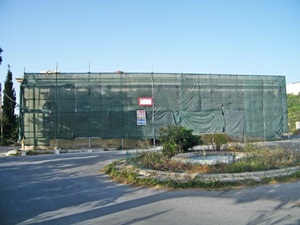




WALK 1 - Valletta to Hamrun
Catch a 'bus to the Valletta terminus. From here, walk to the bridge leading to City Gate, formerly Kingsgate. (When I was in Malta in 1961, Kingsgate was an imposing and elegant arch. Unfortunately it has been replaced with a very plain affair.)
At this bridge, look down on the right. There is another, lower bridge, coming out of a tunnel. This was the exit from the underground Valletta platforms. It may be reached by passing through City Gate and turning right into Independence Square. This was the site of Valletta Station. It was destroyed in the 2nd WW, along with the Opera House, whose ruins can still be seen.
On the right of the square there is an arcade of shops. In them (near the tourist office) is a small unmarked tunnel (1). This leads down to the tunnel exit seen earlier. The actual tunnel is now a (2) garage, but if one asks nicely permission may be given to peer in. During WW2 the tunnel was used as an air raid shelter. From under the bridge there is a walk along the Great Ditch to the Lascaris War Rooms, a recreation of wartime operations.


(L) Valletta station ticket office and rooms as they were. (R) The area after bombing in WW2. In the foreground are the ruins of the old theatre. The station was behind this. Access to the platform was on the right down a ramp (still there).

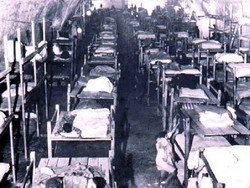
(L) A view inside the old Valetta underground station. Kingsgate can just be see top left of the picture. (R) The station was used as a shelter during WW2.
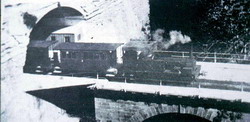

(L) A train leaving Valetta underground station. (R) The bridge today
The line now went through a long tunnel, skirting the granaries in front of St Publius church and an old Roman cistern, to emerge outside the second underground Station, Floriana.
Return to the 'bus station. Continue past the Triton fountain along the palm-lined walk, leaving the Phoenecia Hotel to the right. On the left is a large underground car park. I was told that this has cut into the railway tunnel and there might be plans to do something with it, but at the time (March 1995) access was prohibited (I could find no trace this time).
Cross the road with care and walk through the long narrow gardens. To the right is the old Floriana parade ground with barracks behind (my home for 18 months in 1961!). It is now a football ground and the barracks are offices. To the left is St Publius church with huge underground granaries in front of it. The tunnel is more or less directly below the gardens.


(L) The tunnel entrance. (R) The granaries with St Publius Church behind
At the end of the gardens is Sarria Church. Somewhere about here, the railway tunnellers found an ancient reservoir built by the Knights and had to divert round it. To the right, across the road, is a monument, the Wignacourt Fountain (restored by Din L'Art Helwa, the Malta National Trust) and behind that is a small building belonging to the Ministry of Agriculture. This is the remains of Floriana Station. It is situated near the entrance to the Argotti Gardens. This was also an underground station. The future of this building may be in doubt as there seemed to be some demolition orders posted in 1995. (still there so far!)
By the station a ramp leads down to some lower gardens (Gnien Fillipi). This ramp was constructed for a proposed, but never built, external Floriana Station. The lower gardens are not always open. If they are not, ask at the Argotti Gardens (Through the undergrowth at the bottom you can just see a locked door to what I believe to be the underground station). The visit is worth it because at the far end of the ramparts is not only a view of the route to Hamrun (recognisable by the cupola and twin towers), here is the only view of this side of the last short section of tunnel through the ramparts. It passes through what is called the Fausse Bray, the outer defences in olden times.
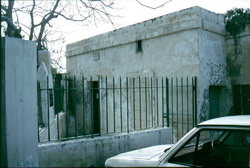

(L) Floriana Station Building. (R) The Ramp leading down to Floriana platforms
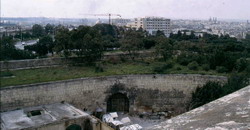

(L) View from Argotti gardens showing the Fausse Bray. Behind, in the trees is Ta' Braxia cemetery and in the distance the towers of Hamrun Church. (R) The exit to the Fausse Bray
Return to Wignacourt fountain and follow Triq (Road) Sarria downhill keeping to the right. In a short while, join the main road and continue downhill on Triq Nazzjonali, reaching Porte de Bombes, the old entrance to the city. Here, on the right, a road (Notre Dame Ditch) passes through ramparts right and left. About 100 metres down this road, on the right, is the bricked-up tunnel exit. This point is directly below the ramparts of the lower garden just visited (The woodwork is deteriorating and you can see inside now). The Fausse Bray tunnel entrance cannot be seen from here as there is a fence in the way.
Return to the main road and walk on down for a few yards to the other side of the Fausse Bray. Take the footpath right for about 50 yards to see the viaduct constructed at the exit of the Fausse Bray. Return to the main road.


(L) View along the viaduct as it leaves the Fausse Bray. (R) View of the Viaduct. Behind is the Porte de Bombes
The next part of the walk only approximates to the line as much of it is built over. Continue on the main road and cross (VERY CAREFULLY!) the bridge over the road to Pieta (Triq Independenza, formerly Princess Melita Road) and Sliema. Ta' Braxia cemetery (another National Trust project and well worth visiting) should be off to the right.
Follow the main road for about a quarter of a mile. The next part is a bit tricky. Shortly after the garage, at the big road junction, the road needed is slightly off to the right but this is up above on a bank! Either bear left for a few yards then climb up sharply right or turn right up Triq Dun Gorg Preca then climb up sharply left. Either way the route should end up in Triq Mile End which is once more on the railway track.
Follow Mile End, across Triq Schembri to reach the gates of Malta Dairy Products. Here can be seen the remains of an embankment leading into Hamrun Station (Not any more, there is a sports ground right up to the road). Looking through the gates (which have MMU, the original milk company, on them) (No, these have gone), gives a view of the area which was once Hamrun Station and Workshops. (These are now the main gates - see below).


(L) Approximately the point where the line crossed Melita Road. (R) The old entrance gate to MDP, now gone.


(L) Inside MDP in the 1990s. The shed entrance can be seen at the back with the second story of the sheds still visible. (R) A close up of the sheds with Hamrun church behind.
Return to Triq Schembri and turn left, then left along Triq Muscat Azzopardi, round the corner and left again into Triq Nuzzo. At the end, on the left is a small square. On the left of this, through some gates (behind MDP) is Hamrun Station building, now the home of Hamrun Scouts. Pop into the courtyard for a quick look (If you can, there are now some locked gates - but you can still see the station and the pot). Note the pot with MR 1912.


(L) The Old Hamrun Station. (R) A bar taken in 1961, somewhere between Hamrun and Birkirkara. Long gone now.
Returning to the square, keep left along Triq Il-Ferrovija. Ferrovija comes from the Italian for railway, ferrovia, meaning iron road. In 1961 I saw, but cannot remember where, railway written as xmundifer from the French chemin de fer also meaning iron road. In the book "The Malta Railway" it is said that the Maltese called the railway Il-Vapur Tal'art meaning the land steamer. So it seems that Malta had more names for the railway than most!
Turn first left along Triq Iskola and left at the end to come to the main entrance of MDP. I am not sure how long MDP will be there as I understand that they may be moving (well, they haven't!). If they are still there, note the MDP milk cartons (gone). Their address is given as Hamrun Railway Station. Whoever is there, asking nicely at the gate will hopefully allow a look right towards the old station and left towards the upper part of the workshops still visible above the modern building (see above for new main gate).
Returning from MDP, follow the short road to the centre of Hamrun for a 'bus back to Valletta.
WALK 2 - Hamrun to St Anton
Return to Triq Il-Ferrovija near MDP. Again, the next section only approximates to the line. At the end of Triq Ferrovia, continue into Triq Cilia. Then, in quick succession, right into Triq Kuncizzjoni, left into Triq Manwel Magri and right into Triq Kapillan Mifsud.
Follow this road across lots of others as it gently bears left and eventually becomes another Triq Il-Ferrovija. In a short while the road reaches a roundabout where it crosses the Sliema Regional Road. Near here was Msida Halt. Continue with great care at the roundabout and on past a number of garden centres towards Birkirkara. There is a fine view of the Msida Valley to the right.


(L) View along path of track at the roundabout mentioned in the text. (R) Along Railway street towards Birkirkara.The street sign says Triq Ferrovija.
In railway days, this was an open valley, but today there are huge villa complexes to be seen. After about half a mile the road also reaches villas. Here, and for several miles, keep a look out for houses with names like "Railway Villa".
The road now becomes called Triq Salvu Psaila as it approaches Birkirkara. At the busy cross-roads (Triq Fleur-De-Lys) there was a major level crossing. There were no gates, just chains. The men responsible for these were sometimes called "Catena Men" , catena being Italian for chain. Continuing, cross with care to Railway Square. There is still a faded sign with this on (gone now). Behind the 'bus stop is the entrance to Birkirkara Station.


(L)The junction with Triq Fleur-De-Lys. The train went across diagonally lower right to upper left. The small carving on the thin building can be seen on an old picture in Bonici and Cassar's book. (R) The now vanished railway square sign.

Birkirkara Station square in 1961. Note the just visible "Station Bar" on the left. Again, this has gone.
The station has been tastefully restored to its original facade and is well worth a look (outside only). Note the original spelling. Here also is the only remaining piece of rolling stock, a preserved third-class carriage. There are also some pretty gardens and two more MR 1912 vases.

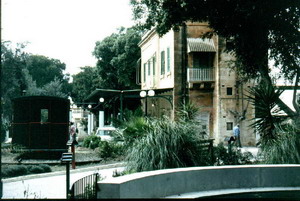


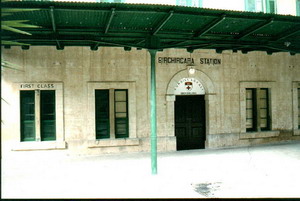
(TL) Entrance to Birkirkara Station, behind the bus. (TR) The Station is on the right and the carriage to the left. (C) One of the 1912 Malta Railway vases. (BL) The preserved 3rd class carriage. (BR) The station facade. Note the Italian spelling.
Leaving the station, the road now becomes Triq Ferrovija L-Qadima. It runs more or less straight through what was once open countryside with views of the Wignacourt Aqueduct but now it is urban development. There are however some smart villas with pretty gardens. Along this stretch was Balzan Station. Eventually the route reaches a boulevard, Vjal De Paula. Here was Sant'Anton Station. On the right are the Sant'Anton Gardens where one may stroll through the plants, or catch the 'bus back to Valletta.


(L)Leaving Birkirkara. (R) On the way to St'Anton.
WALK 3 - St Anton to Notabile.
Returning to St'Anton Gardens, walk down the boulevard a short way and turn right along Il-Linja (The Line). Here, an embankment was constructed which surprisingly still exists. There are two choices here (No, choice A is not now possible because the undergrowth is now so thick it is impassable).
A. Walk along the embankment. This gives a good view of the curve of the embankment and of the Corinthia Palace Hotel to the right. Also, in spring the bank is a riot of wild flowers. I do hope the this little piece of history can be preserved (some new stonework has been added as repair, which is a good sign). The snag comes at the end because there is a bit of a scramble down the bank to get off.


(L) and (R) Two views from the top of the embankment when it was possible to walk along it.
B. Follow the road. Less interesting but there are some details of the embankment construction remaining (and there is no climbing). A bridge with a central pillar once crossed Triq St'Anton but only the side pieces remain. The line then entered Attard Station. To get there, turn left at the bridge then right and right again. There is nothing left of the station but the area has been turned into a very pleasant little park. There is even a train here - sort of!




(TL) Remains of bridge across Triq St'Anton. (TR) Location of Attard Station, now a playground. (BL) This picture I took in 1961. It shows the track leaving Attard. Note the bridge in the distance. (BR) The same view today with the bridge gone.
Triq Il-Linja continues dead straight through a cutting and more housing to a major junction by a supermarket. Bear left here along yet another Triq Il-Ferrovija. The way is mostly straight but is a little tricky just after Triq Hammiela. Try to imagine the old line for the next couple of hundred yards. The objective is to reach a low bridge over a river bed, next to a small grove of trees. At the end of this is the main Rabat road. This was the site of San Salvatore Station. All traces are rapidly disappearing under buildings.

Site of San Salvatore Station in the 1990s
WARNING
At this point the line crossed about a mile and a half of open country. Despite some development, this part is still mainly rural. A lot of the line is now overgrown or ploughed up and is not accessible. Some parts however have been turned into tracks. These are walkable but to get to them requires using two stretches of main road. These are about a quarter of a mile long and have no footpath. Keep right (facing the traffic) and take great care.
{If the above is not appealing, catch a 'bus from San Salvatore to Rabat. From the terminus (Is-Saqqajja) , walk down the hill towards Valletta and turn right along Triq II-Corsa (Racecourse Road) to "Point X" on the main route.}
Turn right along the Rabat road and in about 1/4 mile turn left along a track between two small buildings. In another 1/4 mile the line is met at a cross track. For those who are determined to walk as much as possible of the line, turn left, go to the end and return. Otherwise turn right and follow the line 200 yards to the surfaced road (a dual carriageway, the Qormi road).





(TL) Trackway across fields looking back towards Valletta (TR) The farmer here spoke no English but understood when I said "Ferrovija" and indicated that this was where it went. (C) View across fields to an embankment. (BL) The old bridge, probably now gone. (BR) The ruined bridge mentioned in the text below.
Here the line vanishes again. Turn right and follow the road to a roundabout. Turn left towards Rabat, then in about 100 yards, left again along a small road. Continue in 1/4 mile across the Zebbug road. There is now a view to the left of an embankment sweeping from left to right. Also there is just one arch standing alone in a field (I think this has gone). The road and the line meet in 1/4 mile at the ruins of a bridge. Continue along the road for about 100 yards, then turn sharp right at its junction with a larger road. This road (the Siggiewi -Rabat road) soon starts to climb. About 100 yards before the main road and on the right is
"Point X"
a small building with (very rusty) railings on one side and large greenhouses behind. This was the ticket office for Notabile Station. Notabile was the original terminus of the line. The station building has vanished under the greenhouses.
Going uphill a few yards there is a small track to the right. Just down here is the entrance to the tunnel under Mdina (no entry).
Continue to the main road and follow it uphill to the 'bus terminus. While doing so, think of the poor passengers for whom this climb was a daily occurrence!





(TL) Line of the railway where it entered Notabile Station. (TR) Notabile ticket office. (C) Trackway leading to the tunnel under Rabat in 1961. This is now completely overgrown. (BL) Tunnel entrance in 1995 Again this is almost inaccessible. (BR) Saqqaia and bus station in 1961. Missing now is the guard box and the soldier in front of the red building, but not much else has changed and busses still stop there.
Catch the 'bus back to Valletta or St Julians.
Saturday or Sunday evening meal
This visit may be combined with a trip to Mdina, the Catacombs, or the Roman Villa. Take the 'bus to Rabat and walk to the main entrance of Mdina, Mdina Gate. Cross into the city and turn left along Triq Inguanez. At the end, cross the small square, turn right and immediately left. There is a small exit through the wall. This was constructed to allow access to the station. Passing through, Museum Station is just below, at the bottom of the ramp.


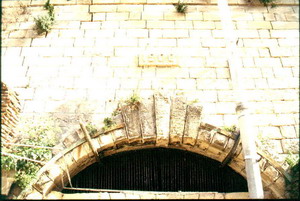


(TL) Alleyway in Mdina, the "Silent City" leading to the "Hole in the wall". This was cut to allow access down a ramp to Museum Station.(TR) View of the "Hole in the wall" from the station showing the access ramp. This was better than from Notabile but not much! (C) The other end of the tunnel. Note the date, 1900. Access to this tunnel is now blocked. (BL) View of Museum Station from Mdina Ramparts. (BR) View of the end of the line and Mtarfa from Mdina Ramparts.
In a picture that I took in 1961, the words "Third class" can just be seen, but the building was deteriorating fast. It escaped dereliction when, in the 80's it was turned into the Stazzjon Restaurant. Now closed - see addendum at the beginning of the page The restoration work is excellent, as is the food. Have a meal, then take a wander round inside, looking at the old pictures, models and postcards.





(TL) Front of station, now the "Stazzjon Restaurant".(TR) Rear view of station. (C) The trackway from the tunnel. (BL) View of Museum Station in 1961. (BR) Inside what was the waiting room.
After the meal, look back along the track towards Mdina to see the tunnel exit with 1900, the year of completion, over the top. The tunnel is now used as a mushroom farm.
Walking the other way the line crosses the Gheriexem Bridge. With a bit of scrambling, some graffiti made during the lifetime of the railway can be seen underneath.
A few more yards, just before the roundabout, is the end of the line. Looking back, imagine the scene all those years ago, when people climbed down from Rabat, and troops descended from Mtarfa Barracks behind, all to catch the steam train to Valletta.


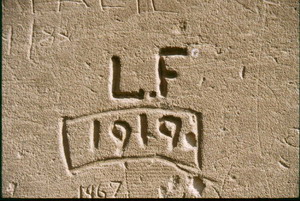


(TL) The platform and awning have been closed in, giving the restaurant another room.(TR) Model engine in the restaurant. (C) and (BL) Old graffiti under Gheriexem Bridge. (BR) View to the end of the line and Mtarfa.
If you do the walks and spot anything interesting, please let me know at don at faydon dot com.
©Copyright Don Gaunt
Click here to go to the Faydon.com Home Page